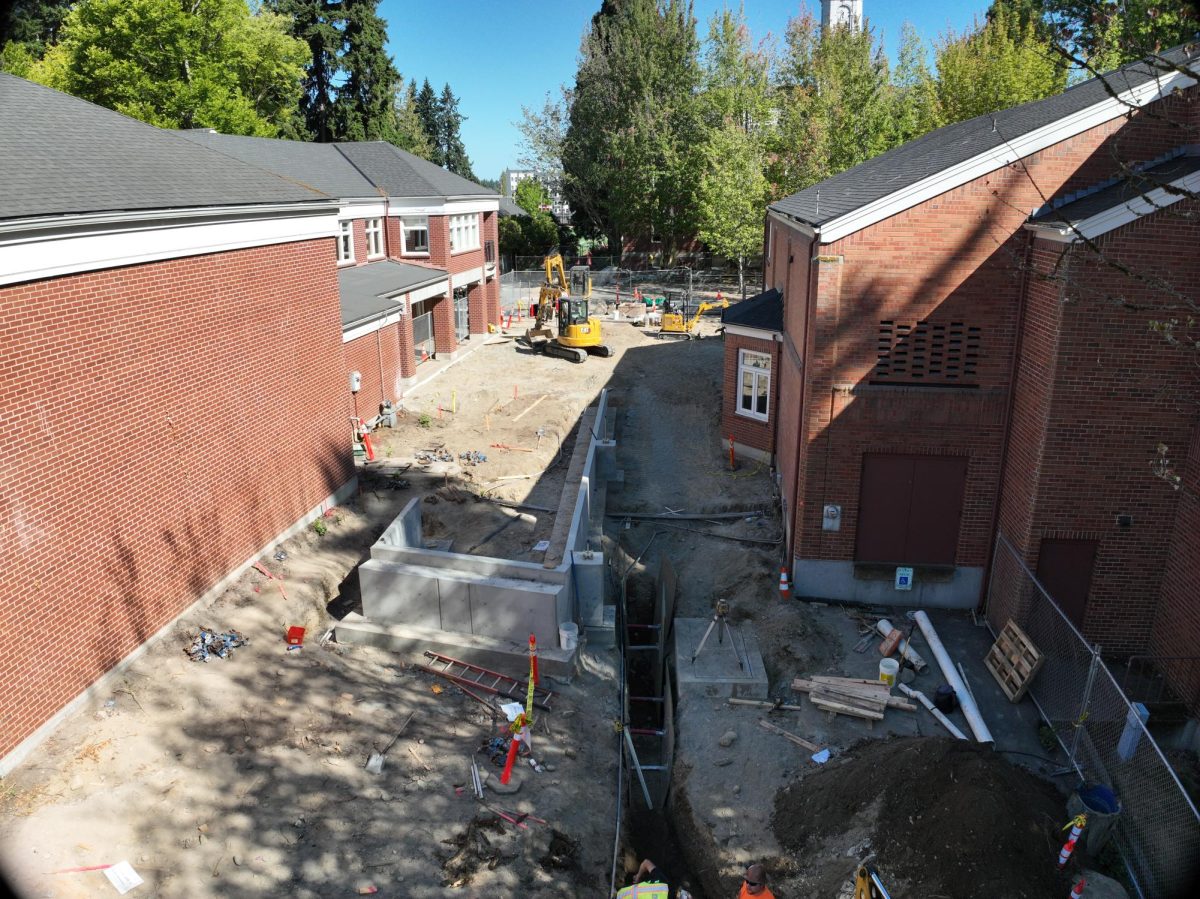A surprise greeted students returning from spring break last year: the tree between Allen-Gates Hall and Pigott Memorial Library was reduced to a stump.
This year, there have been complaints around campus and through the Tatler poll about the construction. This article will specifically address what happened to the plants.
So how did it all begin? When Lakeside requested the architects to design the new building, one of their emphases was on connectedness, according to Ryan Boccuzzi, Assistant Head of School and Upper School Director. So when the architects proposed a “very primary entryway into our main Red Square, the academic hub of campus,” Lakeside was pleased, Mr. Boccuzzi said.
This design entailed a 5,000-pound crane-lifted ramp-bridge to the new building, which rises 14 feet to meet the Vassar Center’s elevation. The ramp is now planned to be wider than any current campus path, including the road to the WCC.
However, one concern arose. The old island between AG and the Library, home to some benches, a mossy tree, and several shrubs, was impeding the path and view of the new building. This obstruction didn’t make the new building feel inviting or connected, Mr. Boccuzzi explained. Also, to meet Americans with Disabilities Act (ADA) standards, the gradual slope of the ramp needed more space. Hence, the island had to go.
Another big scar students noticed returning to campus was the missing rhododendrons in front of Bliss Hall. Their verdant green, famously contrasting with the rustic bricks, was now a skeleton of shriveled twigs and two lengthy ditches.
Jessica Jenness, BNBuilder’s on-site manager for the new building, explained the trench duo was dug to connect the Vassar Center’s electrical system to current infrastructure by St. Nick’s and construct a sewer line to supply Fix Hall with a bathroom.
At first, per request by the administration to preserve as many plants as possible, BNB was careful to minimize impacts. They used a vacuum truck that sucks up dirt through a six-inch-wide hose, which doesn’t destroy tree roots like traditional shoveling.
However, Jessica said, “to perform the trenching, the equipment that’s needed, we had to remove some of the plants and prune back others. [After] the work, some of them that were pruned back [were] pretty extreme.”
The antiquity of Lakeside’s campus made each day of the excavation reveal more surprises. Finding the right pipes among a tangle of old, mismapped piping and roots was a challenge, recalled Mr. Boccuzzi. “We thought we were going to be able to retain more of those large plants. It turned out they cut into a bunch of them, and the large plants that were retained looked kind of silly without any other plants around them.”
Hence, the school gave the go-ahead to take out the standing plants and “replant some new rhododendrons for this new stage of Lakeside,” said Mr. Boccuzzi.
“It was not our desire to overhaul the beautiful flowered rhododendrons that define that square of campus,” he said. “It is always hard to decide what needs to change on a campus when you’re doing a project like this … I would have had a major problem if we [were] losing a substantial amount of overall greenery.”
The planned reinstallation outside Bliss consists of 15 10-gallon rhododendrons, 60 1-gallon shade ferns, 10 5-gallon azaleas, and three vine maples. By the time this article is published, this new flora will be planted. And, distinctly, the front side of Bliss Hall will smell like manure and be laden with mulch.
These conceptual plants are outlined in a drawing provided by Jessica. The drawing was by BNB’s landscaping subcontractor, but the layout was reviewed by Lakeside administrators before the actual planting.
The Fate of the Red Maple
Another notable tree that had to go was one of the red maples in the southwest corner of Red Square. Students may remember fencing put up around that tree nearest to Allen Gates. Well, “it started tipping over. It’s been leaning and leaning and leaning for years, and it was heaving up the soil. There was no way to do a workaround for it to be safe,” explained Dan Dawkins, Lakeside’s Director of Facilities. So, a construction committee decided to take it out.
“We don’t take trees out unless we have to,” he said. “Nobody wanted to do that, but it was the only thing we could come up with that would make the aesthetics of the whole new building walkway safe.”
Unlike the Red Square trees, the one formerly between AG and Pigott didn’t bring up any history. When Tatler talked to Mr. Dawkins and Leslie Schuyler, Lakeside’s archivist, they found there was no plaque for the tree, and nothing about its history was logged in the records. Mr. Dawkins described the island as “a really worn-out tree.“
Nevertheless, since the tree was “a historical piece of campus,” as Mr. Boccuzzi described it, BNB worked with Mr. Joneschild to save some “cookies” — or slices of the tree — for his future classes.
The funding for landscaping the rhododendrons on the southwest corner of Bliss Hall, however, was donated by Elva Kappler Cotton in 1979, mother of Paul W. Cotton ’36. This information is thanks to Ms. Schuyler’s extensive triple-digit Google Sheets catalogue of every donation at Lakeside.
The Tree Report and Lakeside’s Hired Arborist
Aside from the three most noticeable plant removals on campus, many more trees and shrubs were chopped behind the new building and alongside 1st Ave NE. The former was because of construction restrictions, but the latter is more intriguing.
The city of Seattle requires all private property construction to upgrade the frontage, where property meets city streets. Hence, Lakeside installed a new sidewalk and cut down about 10 trees along First Ave for two reasons: either being an impediment to the installation, or because they were dying.
It may come as a surprise to many to learn that Lakeside hires an arborist to review all the trees on campus. Yes, Principal Consultant Sean Dugan and Consulting Arborist Connor McDermott-Grossman from Tree Solutions Inc. assessed 99 of Lakeside’s trees in a 26-page report in advance of the construction, not only gauging the health of each tree but detailing every small fact, from which city department jurisdiction it falls under to species of fungus growing on the tree and canopy symmetry.
A total of 32 trees were marked as recommended for clearance in construction. Additionally, recommended removal procedures were outlined for every tree, with guidelines for projects encroaching on tree protection areas to minimize collateral damage.
However, along with removal, the arborists also recommended 97 trees to be planted; replacement trees are mandated by the city of Seattle for trees removed in construction.
Lastly, every single planned plant removal, no matter how small, is outlined in a Demolition Plan made by civil engineering firm Coughlin Porter Lundeen a year and a half ago before construction, shared with Tatler by Jessica. She noted that, since the Bliss Hall plant removal was decided when construction plans shifted due to new information, it wasn’t in the original plan.
With all the upheavals around campus, Mr. Boccuzzi remains optimistic for the changes, saying, “we have to be ready to embrace some of that evolution and change while also making sure we’re not just reckless about taking away plants that have been here for a long time.”
“I hope we’re striking that balance. That’s the goal,” he said.

